Can a Black Snake Eat a Cardinal Bird? Explained
Black snakes, primarily from the genus Pantherophis, are adept climbers and proficient predators, employing ambush and constriction tactics. Their diet is diverse, including small mammals, birds, and amphibians.
Cardinal birds (Cardinalis cardinalis), with their granivorous diet supplemented by insects, are vulnerable to a range of predators, including black snakes. Evidence indicates that black snakes target cardinal nests, consuming both eggs and juvenile birds, particularly during breeding seasons.
Behavioral adaptations such as nest concealment and mobbing may increase cardinal survival rates but are not foolproof against the stealthy predation strategies of black snakes. Further insights can be explored here.
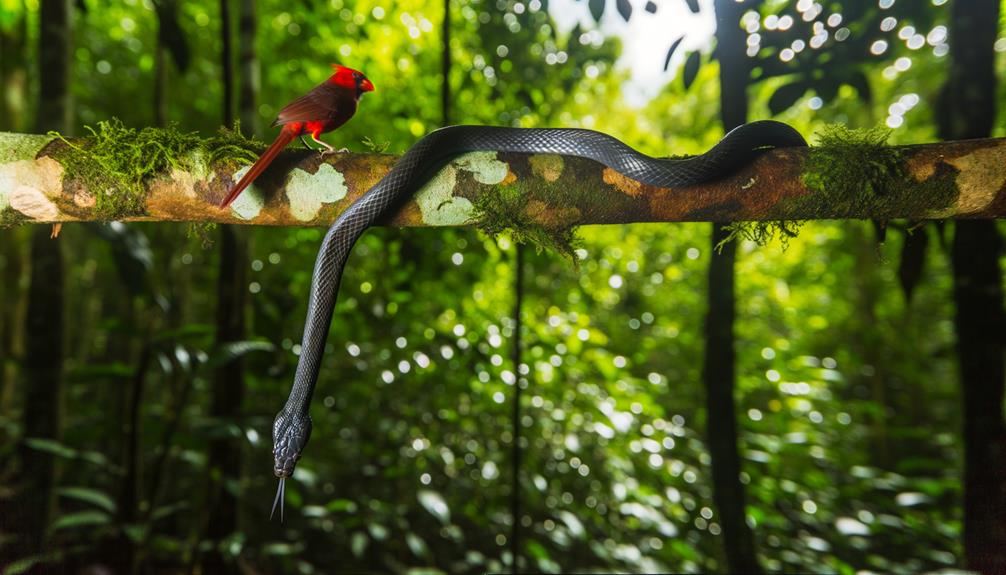
Key Takeaways
- Black snakes are capable of preying on cardinal birds, particularly targeting their eggs and juveniles.
- These snakes utilize ambush tactics and are adept climbers, making it easier to access arboreal nests.
- Cardinal birds employ protective measures like nest concealment, but they remain vulnerable to black snakes during nesting seasons.
- Documented instances show black snakes raiding bird nests and preying on young cardinals.
- The overlap in habitat preferences and activity patterns increases the likelihood of black snakes encountering cardinal birds.
Black Snakes and Cardinal Birds: Predatory Risks
| Aspect | Details |
|---|---|
| Predation on Cardinals | Yes, black snakes, such as the Black Rat Snake, can prey on cardinal birds, especially eggs and fledglings. |
| Hunting Behavior | Black snakes are opportunistic hunters, using stealth to approach nests for eggs or young birds. |
| Diet of Black Snakes | Black snakes primarily eat rodents, birds, eggs, and small mammals. Cardinals may be at risk, particularly during nesting. |
| Cardinal Defense Mechanisms | Cardinals are vigilant and may abandon nests if snakes are nearby. Adults can fend off some predators but not all. |
| Predation Likelihood | Predation by black snakes is more common in areas where nests are low to the ground or in accessible shrubbery. |
Black Snake Overview
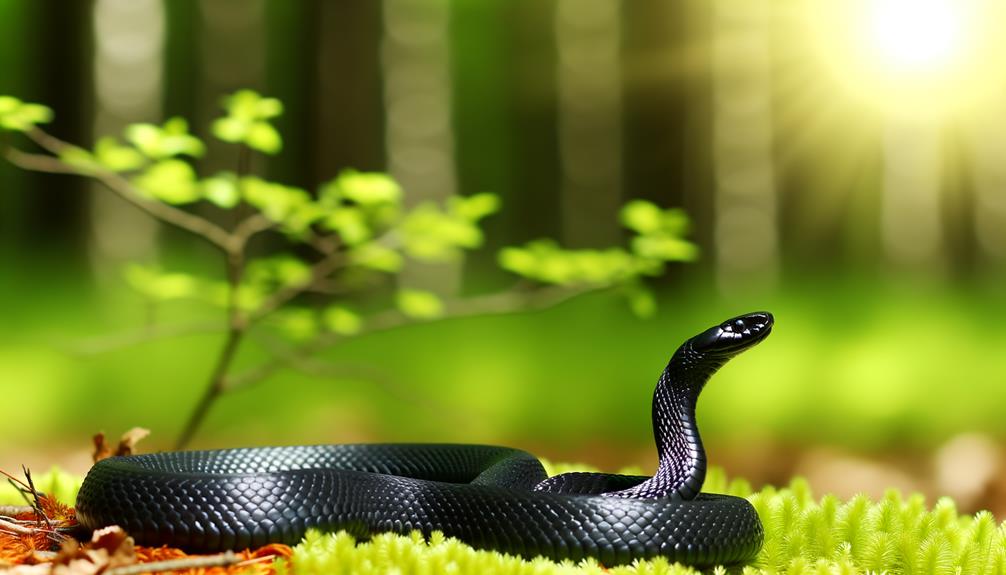
Black snakes, commonly referred to as rat snakes, are non-venomous serpents that belong to the Colubridae family and exhibit a wide geographical distribution across North America. These reptiles are characterized by their robust bodies, smooth scales, and variable coloration, ranging from solid black to patterned morphs. Rat snakes are primarily diurnal, displaying peak activity during daylight hours.
Their diet primarily consists of small mammals, birds, and eggs, reflecting their opportunistic foraging behavior. These snakes are adept climbers, utilizing their muscular bodies to ascend trees and structures in search of prey. Rat snakes play an essential role in controlling rodent populations, contributing to ecological balance.
Their non-aggressive nature towards humans makes them beneficial residents in both rural and urban environments.
Cardinal Bird Overview
Cardinal birds, frequently observed in North America, are renowned for their vibrant plumage and distinctive crest. These passerine birds, scientifically known as *Cardinalis cardinalis*, exhibit sexual dimorphism, with males displaying bright red feathers and females showcasing a more subdued, olive-brown hue.
Cardinals are known for their robust build and strong, conical beaks adapted for seed consumption. Their habitats range from woodlands to residential areas, demonstrating their adaptability.
Key characteristics of cardinal birds include:
- Plumage: Males are vivid red; females are olive-brown.
- Crest: Both sexes possess an erect crest on their heads.
- Beak: Strong and conical, suited for cracking seeds.
- Habitat: Found in diverse environments, including forests and urban areas.
Their melodious songs and striking appearance make them a favorite among bird watchers.
Diet of Black Snakes
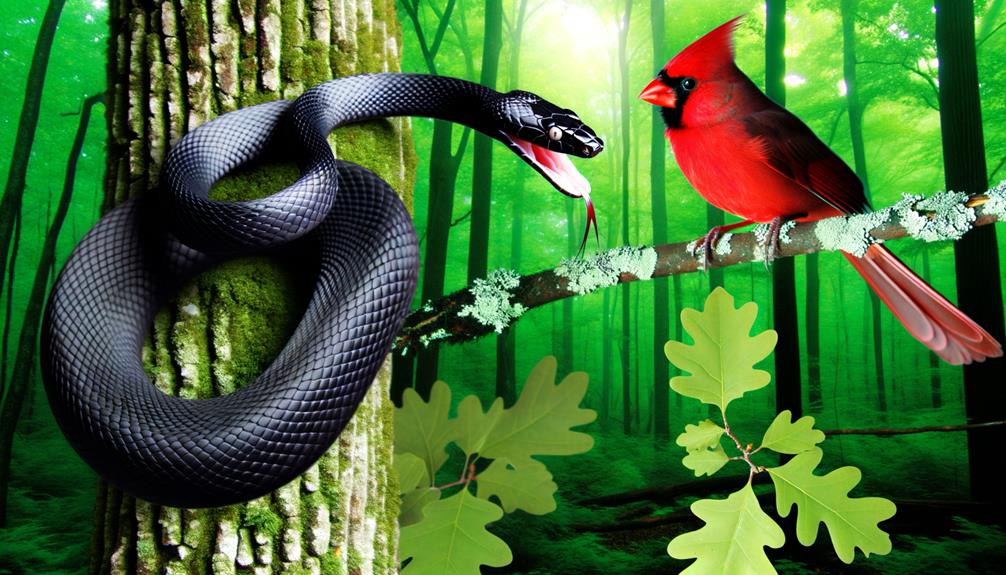
In contrast to the seed-based diet of cardinal birds, the dietary habits of black snakes (*Pantherophis obsoletus*) are mainly carnivorous, encompassing a wide range of prey including rodents, birds, and amphibians. These snakes employ both constriction and ambush tactics to capture and subdue their prey.
Their diet mostly comprises small mammals such as mice and rats, which they locate using keen olfactory senses. Additionally, black snakes opportunistically consume avian species, including eggs and fledglings found in nests. Amphibians like frogs and toads also form part of their nutritional intake.
This varied diet supports their role as effective pest controllers within their ecosystems, highlighting their ecological significance and adaptability to diverse habitats.
Cardinal Bird Diet
Mainly granivorous, the diet of *Cardinalis cardinalis* consists mostly of seeds, which they skillfully extract using their robust, conical beaks. These birds exhibit dietary preferences that reflect their adaptability to various habitats.
Their diet includes:
- Seeds: They favor sunflower seeds, which provide essential fats and proteins.
- Fruits: Cardinals consume berries, such as dogwood, and small fruits, which offer vitamins and sugars.
- Insects: Invertebrates like beetles and caterpillars are vital, especially during the breeding season for increased protein intake.
- Grains: They occasionally feed on grains, such as corn and oats, supplementing their nutrient intake.
This diverse diet aids in their survival and reproductive success, allowing them to thrive across a wide geographical range.
Natural Predators of Cardinals
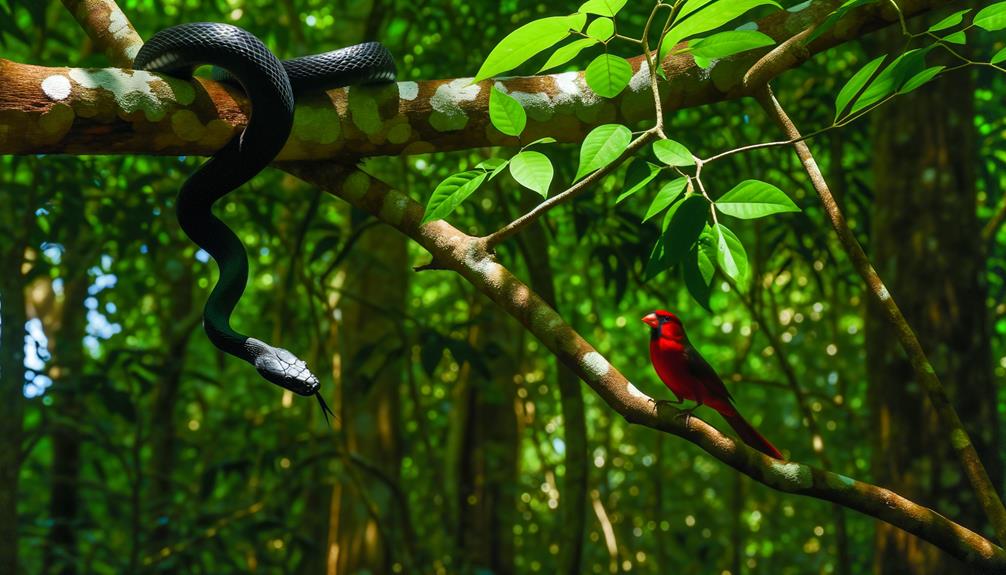
A variety of natural predators, including birds of prey, mammals, and reptiles, pose significant threats to the survival of *Cardinalis cardinalis* in the wild. These predators are integral components of the ecosystem, impacting cardinal populations through predation. The table below illustrates common predators of cardinals, focusing on their respective classes and predation methods:
| Predator | Class | Predation Method |
|---|---|---|
| Cooper’s Hawk | Aves | Aerial attack |
| Domestic Cat | Mammalia | Stalking and pouncing |
| Black Rat Snake | Reptilia | Constriction |
| Eastern Screech Owl | Aves | Silent swooping |
| Raccoon | Mammalia | Opportunistic scavenging |
Understanding these natural threats is essential for conservation strategies aimed at ensuring the continued survival of the cardinal species.
Hunting Techniques of Black Snakes
Black snakes are adept hunters, using a mix of ambush and stealth tactics to capture prey. They strategically position themselves to catch unsuspecting victims. Their primary method of subduing prey is constriction, where they wrap their bodies around the target to hinder breathing and cause asphyxiation.
Once the prey is subdued, the snake uses specialized jaw mechanics to swallow it whole. This unique adaptation enables black snakes to ingest relatively large organisms like cardinal birds.
Ambush and Stealth Tactics
Employing a combination of ambush and stealth tactics, black snakes utilize their cryptic coloration and patient stalking abilities to effectively capture their prey, including the cardinal bird. These serpents leverage their environment and physiological adaptations to maximize hunting success.
Key components of their strategy include:
- Camouflage: Their dark, often matte scales blend seamlessly with forest floors and shaded areas, making them nearly invisible to unsuspecting prey.
- Patience: Black snakes exhibit remarkable patience, remaining motionless for extended periods to avoid detection.
- Silent Movement: Their ability to move silently through underbrush minimizes disturbances, reducing the likelihood of alerting potential prey.
- Strategic Positioning: They position themselves near likely prey pathways, such as bird feeders or nests, optimizing their chances for a successful strike.
These combined tactics make black snakes formidable hunters.
Constriction and Swallowing Methods
Utilizing powerful muscles and precise timing, black snakes employ constriction as their primary method for subduing prey like the cardinal bird.
Upon seizing the bird, the snake rapidly coils its body around the victim, exerting pressure that disrupts respiratory and circulatory functions. This method guarantees quick immobilization and prevents escape.
Once the prey is incapacitated, the snake initiates swallowing, employing a series of complex jaw movements known as ‘pterygoid walking.’ This process, facilitated by highly flexible ligaments in the skull, allows the snake to consume prey larger than its head.
Salivary enzymes begin the digestion process even before the prey reaches the stomach, ensuring effective nutrient absorption.
Black snakes exhibit remarkable anatomical adaptations, optimizing their predatory efficiency.
Habitat Overlap
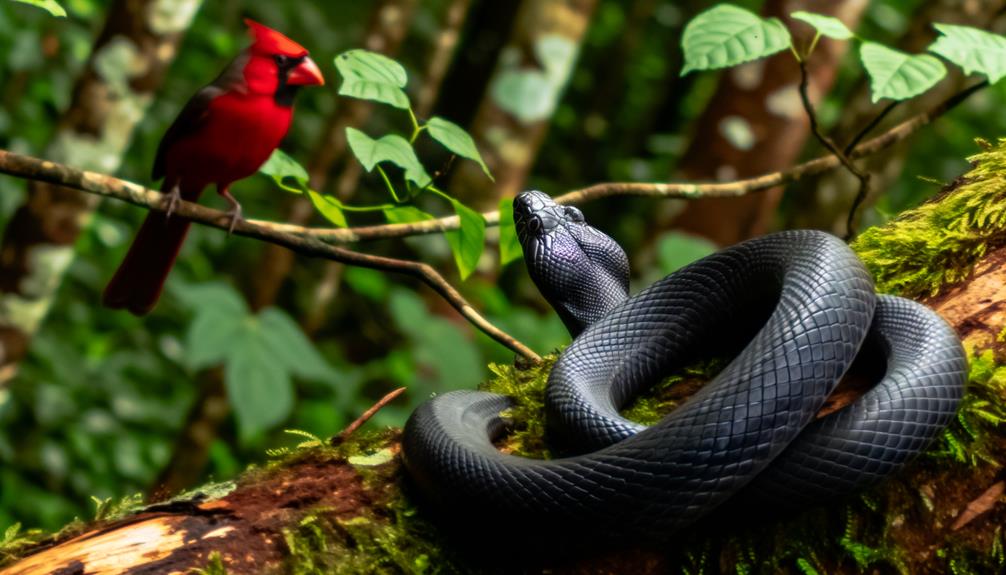
The habitat overlap between black snakes (Pantherophis obsoletus) and cardinal birds (Cardinalis cardinalis) primarily occurs in deciduous forests, woodland edges, and suburban areas, which provide both species with essential resources.
This geographical coincidence facilitates predatory interactions, as black snakes exploit these shared environmental zones to engage in opportunistic hunting of avian species.
Understanding the intricacies of their cohabitation can elucidate the broader food chain dynamics within these ecosystems.
Shared Environmental Zones
Habitat overlap between black snakes (Pantherophis obsoletus) and cardinal birds (Cardinalis cardinalis) is frequently observed in temperate forests, grasslands, and suburban areas, where both species exploit similar ecological resources. This cohabitation is facilitated by several environmental factors:
- Vegetation Density: Both species thrive in areas with moderate to dense vegetation, providing shelter and hunting grounds.
- Food Availability: Insects, small mammals, and seeds are abundant, serving as primary food sources for both organisms.
- Water Sources: Proximity to bodies of water guarantees hydration and supports a rich biodiversity essential for food.
- Climate Conditions: Both species are adapted to temperate climates, which offer favorable conditions for nesting and activity.
Understanding these shared environmental zones provides insights into their ecological interactions.
Predatory Behavior Patterns
Given the shared environmental zones of temperate forests, grasslands, and suburban areas, the predatory behavior patterns of black snakes (Pantherophis obsoletus) towards cardinal birds (Cardinalis cardinalis) become increasingly significant for understanding their ecological interactions.
Black snakes are known for their opportunistic hunting strategies, which include ambush predation and active foraging. They exhibit remarkable climbing abilities, enabling access to bird nests located in shrubs and low trees. Cardinals, while primarily ground foragers, nest in locations that overlap with the snakes’ hunting range.
The temporal activity patterns of both species often coincide, especially during dawn and dusk, increasing the likelihood of predatory interactions. By analyzing these behaviors, we gain insights into the complex dynamics of predator-prey relationships within these overlapping habitats.
Food Chain Dynamics
Understanding the intricate food chain dynamics within overlapping habitats of black snakes and cardinal birds requires a detailed examination of their ecological niches and interspecies interactions. Both species inhabit deciduous forests and suburban areas, leading to potential predator-prey relationships.
Key elements influencing these dynamics include:
- Habitat Structure: Dense vegetation can provide cover for both predators and prey, impacting hunting success rates.
- Temporal Activity Patterns: Diurnal activity of cardinal birds contrasts with the mainly crepuscular or nocturnal behavior of black snakes.
- Dietary Preferences: Black snakes exhibit opportunistic feeding behavior, while cardinals mainly consume seeds and insects.
- Predation Risk: Juvenile birds and eggs are more susceptible to predation by black snakes compared to adult cardinals.
These factors collectively shape the intricate food chain dynamics within their shared habitats.
Snake and Bird Interactions
Interactions between snakes and birds are complex and multifaceted, often involving predation, competition, and ecological balance within their shared environments.
Predation is a primary interaction, where snakes, including black snakes (Pantherophis obsoletus), may target avian species such as the Northern Cardinal (Cardinalis cardinalis) for sustenance. These predatory events can impact bird populations, particularly in nesting periods when eggs and fledglings are vulnerable.
Additionally, snakes and birds may compete for shared food resources, such as insects and small mammals. Such interactions necessitate a dynamic equilibrium where both taxa influence each other’s population dynamics and behavioral strategies.
Understanding these interactions provides insights into broader ecological processes and the adaptive mechanisms employed by both predators and prey within their ecosystems.
Evidence of Predation
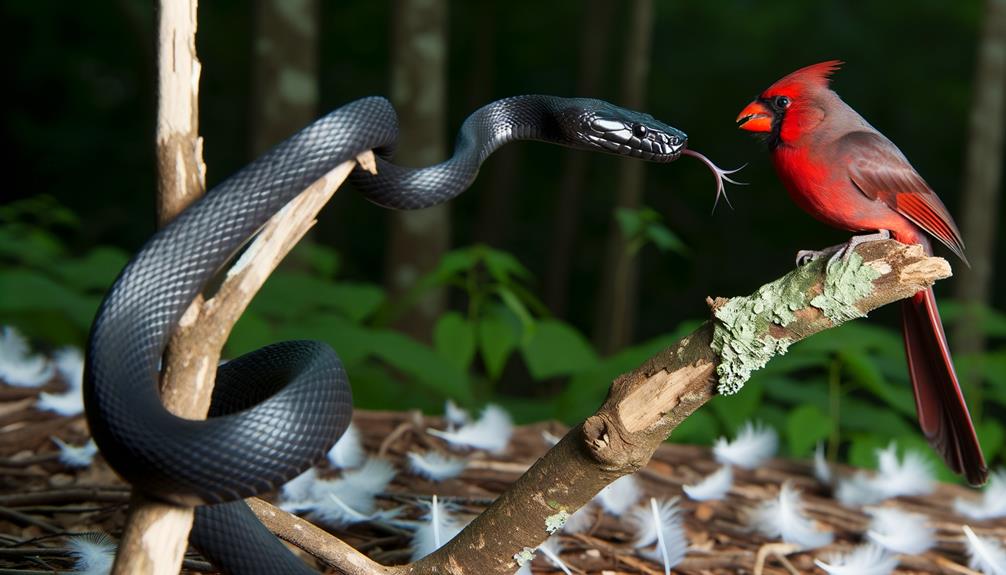
Numerous documented instances of predation establish that black snakes, specifically Pantherophis obsoletus (Eastern Ratsnake), have been observed preying on cardinal birds (Cardinalis cardinalis).
Detailed analysis of predator-prey dynamics reveals that these snakes utilize arboreal hunting strategies to access nests and capture avian prey.
Observational studies corroborate these findings, indicating a significant impact on cardinal populations in habitats where black snakes are prevalent.
Documented Predation Instances
Empirical studies and field observations have documented instances where black snakes (Pantherophis obsoletus) have preyed upon Northern Cardinals (Cardinalis cardinalis), providing concrete evidence of interspecies predation. These documented instances are critical for understanding the ecological interactions between these species.
Specific observations include:
- Nest Raids: Black snakes have been observed raiding cardinal nests, consuming eggs and nestlings.
- Juvenile Predation: Juvenile cardinals, being less agile, are more susceptible to predation by black snakes.
- Direct Capture: Adult cardinals have been captured by black snakes during vulnerable moments, such as feeding or resting.
- Telemetry Data: Radio telemetry studies have tracked black snakes to cardinal nesting sites, confirming predation occurrences.
These instances underscore the predator-prey relationship between black snakes and Northern Cardinals.
Predator-Prey Dynamics
Analyzing the predator-prey dynamics between black snakes and Northern Cardinals reveals intricate behavioral patterns and survival strategies employed by both species.
Black snakes (Colubridae family) utilize ambush predation, relying on stealth and camouflage to capture unsuspecting prey such as the Northern Cardinal (Cardinalis cardinalis).
Conversely, Northern Cardinals have evolved acute visual and auditory senses to detect potential threats, often engaging in alarm calls and evasive maneuvers.
The spatial distribution and habitat preferences also play critical roles; black snakes often exploit dense vegetation where cardinals nest.
This interaction underscores the delicate balance within ecosystems, where predation pressure can influence avian reproductive success and snake dietary habits.
Such dynamics are integral to understanding broader ecological processes.
Observational Studies Outcomes
Field observations and ecological studies have documented instances of black snakes predating on Northern Cardinals, providing substantial evidence of this predator-prey interaction in natural habitats. These findings are essential for understanding the dynamics between these species.
Key observations include:
- Direct Observations: Instances where black snakes have been seen capturing and consuming Northern Cardinals.
- Nest Monitoring: Studies showing higher predation rates in nests located within the black snake’s habitat range.
- Predation Evidence: Discovery of cardinal feathers and remains in the digestive tracts of captured black snakes.
- Behavioral Responses: Notable changes in cardinal nesting behavior and vigilance in areas with a high black snake presence.
These observational outcomes collectively underscore the significant impact of black snake predation on Northern Cardinal populations.
Ecological Impact
The predation of cardinal birds by black snakes can alter local ecosystems by disrupting avian population dynamics and food web structures. This interaction affects both predator and prey species. The decrease in cardinal numbers can lead to a reduction in seed dispersal and insect population control, roles that cardinals typically fulfill. Additionally, black snakes may experience changes in their own population dynamics due to variations in prey availability.
| Impact Area | Consequence |
|---|---|
| Avian Population | Decline in cardinal numbers |
| Seed Dispersal | Reduced dispersal of native plant seeds |
| Insect Control | Increased insect populations |
| Snake Population | Altered black snake population dynamics |
| Food Web Balance | Disruption in local food web structures |
Understanding these impacts is essential for maintaining ecological balance.
Protective Measures by Cardinals
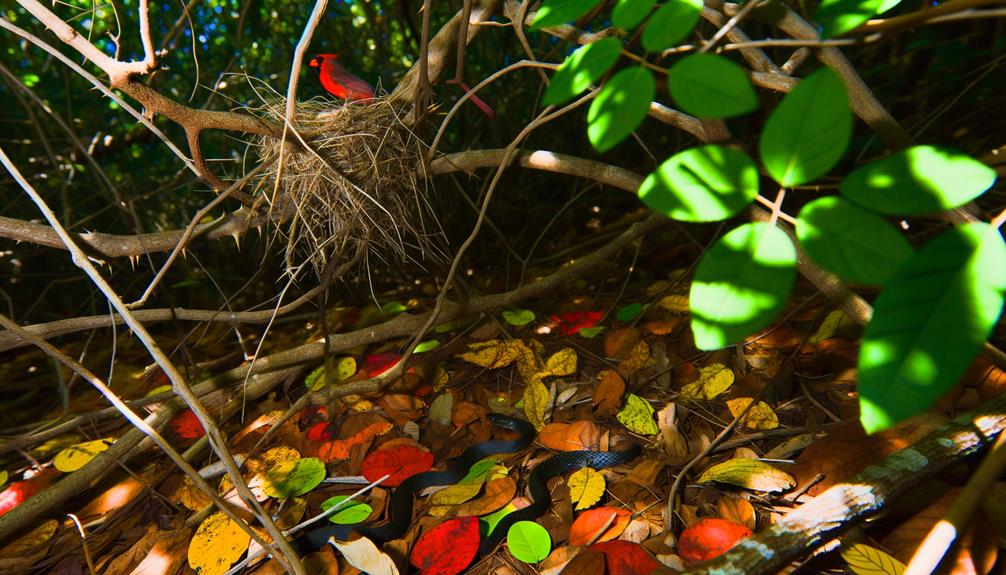
Cardinals employ a variety of defensive behaviors to protect their nests from predators, ensuring the survival of their offspring. These behaviors are vital and encompass key protective measures.
- Aggressive Mobbing: Multiple cardinals may attack a predator, using their beaks and wings to drive it away.
- Alarm Calling: Vocalizations are used to warn other birds of a predator’s presence, creating a communal defense system.
- Nest Concealment: Cardinals often select nesting sites with dense foliage to obscure the nest from predators.
- Distraction Displays: Some cardinals may feign injury to lure predators away from their nests, a behavior known as the ‘broken-wing act’.
These strategies collectively enhance the cardinals’ ability to safeguard their progeny.
Observations in the Wild
In numerous documented cases, researchers have observed black snakes preying on cardinal nests, providing critical insights into predator-prey dynamics in avian ecosystems. Field studies have noted that black snakes, particularly Pantherophis obsoletus, exhibit arboreal behavior, enabling them to access cardinal nests situated in trees.
Observations indicate that these snakes often target nests during the breeding season when nestling availability is highest. Detailed analyses of predation events reveal that black snakes utilize their climbing proficiency and stealth to approach and consume both eggs and nestlings. Such predatory interactions profoundly influence cardinal reproductive success and highlight the role of snakes as apex predators in controlling avian population dynamics.
This underscores the intricate balance within ecosystems and the adaptive strategies employed by both predators and prey.
Conclusion
To sum up, black snakes, owing to their opportunistic feeding habits, can indeed prey upon cardinal birds, as evidenced by documented instances of avian predation.
While cardinals employ various protective measures, such as camouflage and nest concealment, the adage ‘nature takes its course’ aptly describes the inevitability of such predatory interactions.
Understanding these dynamics is essential for comprehending the intricate ecological balance and the evolutionary adaptations that shape the behaviors of both predator and prey within their habitats.






